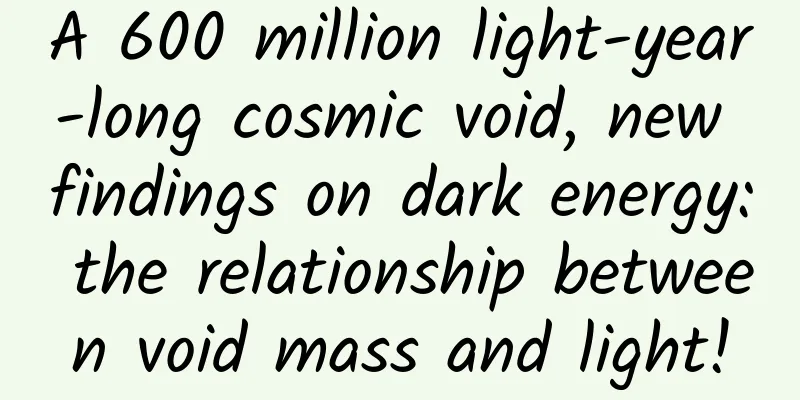A 600 million light-year-long cosmic void, new findings on dark energy: the relationship between void mass and light!

|
The Dark Energy Survey (DES) uses patterns in macroscopic cosmic structure seen in the spatial distribution of billions of galaxies to reveal the nature of "dark energy," the most likely cause of the accelerating expansion of the universe. Since it began in 2013, the Dark Energy Survey has mapped more than 10% of the sky using a 570-million-pixel digital camera and five filters that provide galaxy colors to estimate redshift distances. Astronomers at the Harvard Smithsonian Center for Astrophysics are part of a team of more than 400 scientists in seven countries studying dark energy, and last year it released its first set of data. "Cosmic voids occupy a large portion of the volume of the Universe, and unlike galaxy clusters and other compact structures that are strongly influenced by gravitational effects, not to mention processes associated with galaxy formation, these voids are the lowest-density regions in the Universe with relatively simple dynamics, which makes them particularly simple to constrain cosmological parameters. Astronomers at the Harvard Smithsonian Center for Astrophysics analyzed the first data release with the goal of describing the relationship between mass and light around cosmic voids. The scientists used statistical models to analyze the two-dimensional and three-dimensional distribution of galaxies." The latter is obtained by calculating the distances to galaxies from the redshifts measured by photometry. The two methods are found to agree well with each other and with models in which the physics of void environments is very simple and the amount of emitted light is proportional to its mass. Voids with diameters between about 100 million and 600 million light years are well-suited to enable mass-to-light tests to better than 10%. With future, more advanced observations, the improved statistics should enable useful new consistency tests of gravity, general relativity, and dark matter scenarios. What are the masses and galaxy profiles of cosmic voids? In the new study, researchers used two methods to extract voids in the Dark Energy Survey (DES) one-year redshift galaxy sample to address this question. Voids were identified using either a 2D distribution, or a 3D distribution of galaxies based on photometric redshift. For the mass profile, the study measured the tangential shear profile of background galaxies to infer the excess surface mass density. For both void samples, the measured signal-to-noise ratio was between 10.7 and 14.0. Their 3D density distribution was inferred by model fitting based on N-body simulations, and good agreement was found for void radii in the range of 15-85 MPC. By comparing with galaxy profiles, the relationship between mass and light can be tested at the 10% level, which is the most stringent test to date. We also found that the shapes of the two profiles are very similar, and the linear relationship between mass and light is consistent both inside and outside the void radius. We validated our analysis with the help of simulated star catalogs and estimated the impact of the photometric redshift uncertainty on the measurement. The methodology can be used for cosmological applications, including gravitational tests with voids. This is particularly promising when gravitational lensing profiles are combined with spectroscopic measurements of the void dynamics through redshift space distortions. Bokeyuan|www.bokeyuan.net Boco Park | Research/From: Harvard Smithsonian Center for Astrophysics Reference journal Monthly Notices of the Royal Astronomical Society DOI: 10.1093/mnras/stz2805 BoKeYuan|Science, technology, research, popular science |
<<: The History of Vaccines: Technologies, Diseases, and Challenges
Recommend
Who is the baby? The correct way to calculate the dog's age
Dogs are man’s best friends. We often say that on...
Will high-price strategy feed back into marketing growth?
Yesterday, after "Cong Yan Cong Yu" att...
Marketing: Apple says no one dares to be number one?
John Sculley, this seemingly unfamiliar name, act...
Keep operation strategy and gain 170 million users in 4 years!
Recently, keep became popular again with its new ...
Green Onion Metal Standard Edition Review: A Transformation, Two-thirds Success
The mobile phone market has long been a bloody ba...
Does Douyin Blue V need a business license? How to authenticate Blue V?
Douyin is a platform dedicated to publishing and ...
Why are 5G mobile phones not selling well?
This year, the iPhone 11 series triggered a rush ...
How to secretly take photos of me at work? This year's "Funny Wildlife Photo Award" is full of emojis!
It's Wednesday, does anyone want to go to wor...
Liu Xifang's 21-day Victoria's Secret vest line micro course
Introduction to Liu Xifang's Victoria's Se...
Collection: 68 information flow ads and SEM learning website resources are available for free!
01. CNZZ -UDplus Website: udplus.umeng.com Note: ...
How much does it cost to make Baidu entries for an enterprise?
For users, Baidu Encyclopedia is an online encycl...
Interesting fact: Was steamed bun invented by Zhuge Liang?
Steamed buns were invented by Zhuge Liang In the ...
What is an airplane black box? How many are there? What color is it?
At present, rescue work at the scene of the China...
Game controllers for Three Kingdoms Killing: Xiaomi, Xiaoqi, and Xinyou all have their pros and cons
Game controllers have never been as popular as th...
How to play with short videos in information flow? 5 ideas + 3 case references!
Advertising has been evolving, have your marketin...





![[Smart Farmers] From the Sea to Shandong Cuisine Table - The Magical Journey of Sea Intestines](/upload/images/67f236464da6a.webp)



